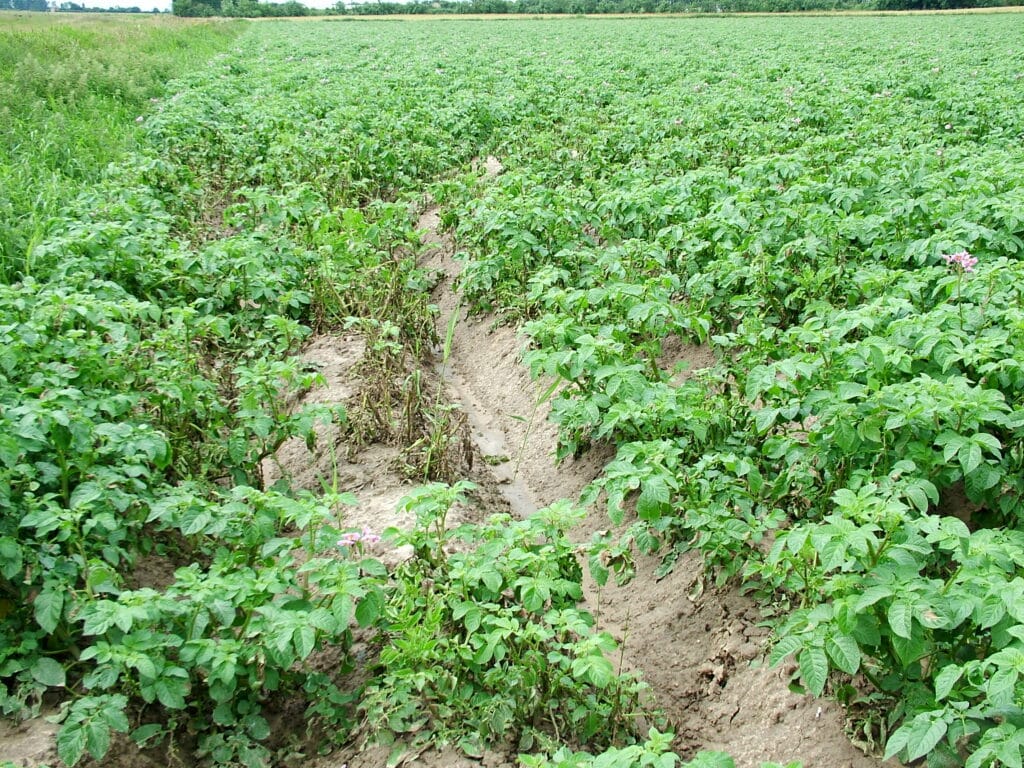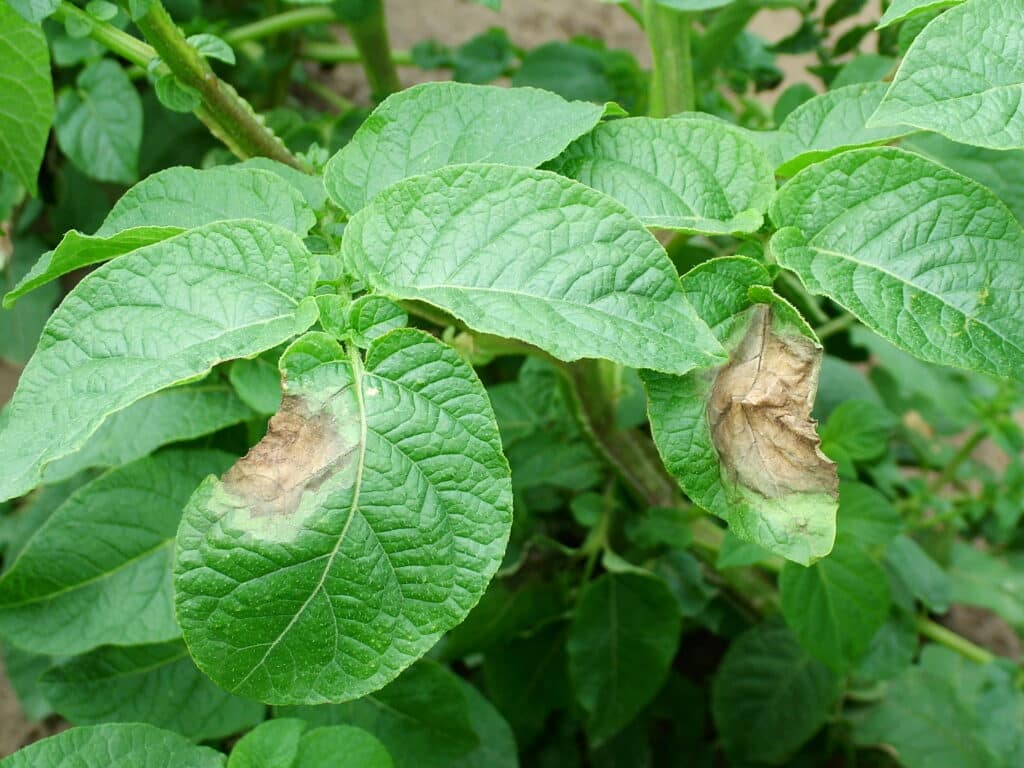Seasonal strategies to beat blight and more in potato growing – British Potato Review
This month, Andrew Goodinson looks at late strategies for blight control, powdery scab and herbicide, offering key insights into how to achieve the best efficacy ...
Sequences of different actives from different fungicide groups are key to effective late blight control, while because they have different modes of actions, there will be a reduction in the likelihood of increasing resistance, according to Andrew.
“The loss of mancozeb, a multisite active, will make blight strategies even more crucial and make blight control decisions more challenging because it has been such a cost-effective cornerstone to blight control strategy,” he said.
New potassium phosphonates, which are looking to be effective when co-formed with blight actives, could offer a future solution. These have a different FRAC code to other products.
“We need to adapt, learn and move on when an active is withdrawn,” said Andrew. “Of course, we also need to minimise resistance developing, so no blight programme should use single active applications. Fungicides should be used in mixes or alongside alternating partners – and stewardship guidelines should always be followed.
“The choice of fungicides depends on the conditions in the field at the time and we also need to follow the Fungicide Resistance Action Group (FRAG) guidelines.”
Last year EU_36 was the most prevalent blight strain in GB, followed by lower levels of EU_6 and EU_13. So far, anti-resistance strategies have kept OXTP resistant blight genotype EU_43_A1 (EU43) at bay, but there were outbreaks of the strain in Wales and Scotland and some of these were not sensitive to OXTP.
Andrew warned growers not to take chances with blight control this year.
“It is best to start blight control programmes when the crop is at the rosette stage, and continue at seven-day intervals following a strategy that alternates actives across the different fungicide groups so we can avoid putting a single active under pressure.
“Effective blight control is about building up the product in and on the crop as it develops, so to minimise missed blight sprays during wet weather, it is often a good idea to start the seven or 10-day spray programmes on a Monday.
“This means that if you miss a day or two, you are not then up against a weekend.”
When forecasting models indicate blight pressure risk is lower, cheaper fungicides can be used, but it is really important not to extend the intervals, he added. This is because spraying when a plant is already infected can encourage blight resistance.
Andrew said application techniques are important. Too-high speed and less-than-ideal water volumes reduce efficacy, as do applications, when the weather is hot and the stomata are shut down.
Where crops are irrigated, he also cautions about the importance of not underestimating drying time after irrigation before spraying, and water in tramlines splashing leaves.
“When planning your planting, avoid areas where you cannot get in to spray, such as under trees, around obstacles and tight corners – you can usually identify these areas as they are full of weeds because your herbicides are unlikely to have covered them.”
Outbreaks of fluazinam-insensitive blight strain EU_37 (formerly known as Dark Green 37) have been less prevalent thanks to good stewardship practices, and he notes fluazinam still plays an important role in a blight spray programme.
“It needs mixing with co-actives, and should only be used after full canopy development in a mix at full rate (400ml/ha). We used to use fluazinam for the first spray, but we now tend to use for cyazofamid and for the second spray we often follow it with fluopicolide + propamocarb because they work well with the crop at this stage.”
Andrew finds mandipropamid remains a good-value fungicide, particularly when it is mixed with cymoxanil. It is also more rain-fast than other blight spray products, so can be switched into the programme when weather is showery. There may be cases of potential resistance but this has not yet been confirmed in the UK.
“The addition of adjuvants and drift retardants help improve cover, but will not affect any insensitivity already shown by a particular blight strain,” said Andrew.
At the early to mid-season slot (rapid canopy growth), he said he finds oxathiapiprolin (OXTP) very useful because it is effective, persistent and it moves well round the plant.
Andrew highlights the importance of choosing the right spray nozzle for the task. “The IDTA04 Flat Fan and the 3D Ninety nozzles offer the best coverage because they are designed to cover all of the canopy including the underside of the leaves.”
He reminds growers that some of the newer blight strains can incubate during colder periods, and that spores can travel a long way in the wind.
“We often underestimate the spread of blight inoculum from volunteer potatoes growing in other, as well as in allotments and gardens.”
Andrew often recommends strategic use of biostimulants to help reduce crop stress, noting that crop health and resilience play a role in plant health, therefore help the plant’s defences against disease such as blight. He reminds growers that when a plant is stressed, it uses the same pathway as disease response jamming its natural defence mechanisms.
“Product formulations containing manganese and zinc are being trialled to assess whether they can help reduce infection,” he said. “Zinc reduces spore penetration, while manganese contributes to general crop health. However there is more work to be done in this area to refine our understanding and knowledge of how these elements work.”
He notes that while many growers are good at mid-season blight control, they are not pro-active enough at the beginning of the year or when the desiccation period is longer than normal.
“Ensuring you have a robust blight programme throughout the season is more essential than ever. As such, it is crucial to keep up to date with the strains prevalent during the season, and we can all help by sending in samples for analysis in the Fight Against Blight campaign.”
Powdery scab insights
Cool, wet summers and over-irrigation can exacerbate incidence of powdery scab (Spongospora subterranea), which is often present in the soil, Andrew points out, noting that PMTV is transmitted by the same soil-borne pathogen.
“Powdery scab can produce cankers and deformations on the tubers, and decimate a seed crop so that the only market is stock feed or anaerobic digesters (AD),” he said.
Andrew believes fluazinam is the only active that can reduce levels when applied in furrow, but is only recommended in seed crops.
“If you use fluazinam for powdery scab, it cannot then form part of a late blight control strategy, because of the insensitivity issues on some strains,” he said.
Powdery scab can frequently be seen on seed. Once spores are released into the soil, it survives more than 15 years.
“The critical time for powdery scab development is tuber initiation, just when growers are irrigating to reduce the risk of common scab, because the powdery scab spores need soil moisture to move from mother tubers to daughter tubers. Clean seed is therefore crucial, particularly as spots of powdery scab can often be missed at planting.”
He adds that field history is a good guide to risk, and recommends growers avoid poorly drained soils and over irrigation.
Top tips for devising a herbicide strategy
An early pre-emergence herbicide application is key not only to efficacy but also minimising the risk of holding back or scorching crops on the cusp of emerging, Andrew said.
“In the past, we used to spray just before emergence, but we now know that when the potato plants are just below the surface they can be adversely affected by a herbicide,” he said, adding that potatoes are planted deeper than many other crops, which reduces the chance of damage until shoots are just below the surface. “Nevertheless, on lighter soils it is best to spray both residual and contact herbicides well before emergence.”
Metribuzin is the backbone of most weed control strategies in potato crops, he said, pointing out that on fenland or mineral soils, it can be incorporated at around planting time, without compromising the young tubers.
“Most strategies are based around metribuzin as a general rule, with other products being added to the mix depending on weed spectrum and soils.”
He notes that early weed control products carfentrazone and metobromuron offer effective control of broad-leaved weeds but are not effective on grassweeds and volunteer cereals.
“However, of course, seasons do not always go to plan, and when unexpected weather events result in a flush of weeds well before emergence, there is an option to use Roundup Flex immediately after planting. This is the only glyphosate product with approval for pre-emergence, and it should be used when the shoots are still well below the surface, and there is no ridge-cracking.”
Should spraying be delayed, he advised, avoiding actives such as clomazone or pendimethalin because they can affect the growing point of the crop.
“In this case, opting for a mix of metribuzin + a sulfonylurea herbicide is an alternative because they work on small, actively growing weeds, and can target weeds at cotyledon four-leaf stage.”
Moving on to talk about residual herbicides, he observes that they should be applied between 7-10 days after planting, and can be followed up around three weeks later with a contact herbicide and/or a second residual with a different mode of action (MOA).
“However, some varieties are sensitive to metribuzin, so checking tolerance with the breeder, or the variety list from the product manufacturer is always a good idea, particularly if you are growing a variety that you have not grown before.”
For weeds that can be difficult to manage, such as cleavers, Andrew recommended a mix that includes metribuzin and prosulfocarb. “However, if you are growing varieties that are susceptible to metribuzin, metobromuron and prosulfocarb or aclonifen can provide an alternative.”
He also reminded growers who are planning to plant a second crop, such as onions, to bear in mind that some herbicides can leave residues. “Prior to application, it is always advisable to check the label for the product’s persistence in the soil.”
Knowing the field history and what is in the seed bank helps build an effective strategy, although this can be more difficult for growers who rent land.
“If you find that pressure from black nightshade or cleavers is very high, bentazone can be particularly useful to add into your programme,” he said, cautioning that getting the timing right can be difficult. “Moreover, care needs to be taken to ensure compliance with stewardship guidelines and ensuring the product does not get into groundwater.”
He also reminds growers not to spray when heavy rain is forecast, because of the risk of run-off into water courses. “We must not allow ourselves to become complacent about run-off,” he said.


